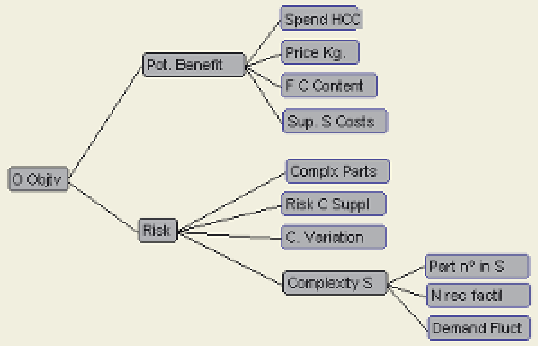Information Technology Reference
In-Depth Information
On the other hand,
Risks
is split into four sub-objectives.
Complexity of parts
(Complx Parts)
represents part of the risk of selecting a new supplier. Technical issues related to quality and
material specification could be added to the assessment of the total complexity of parts in
each segment. A higher complexity implies a higher risk.
Risk with current suppliers
(Risk C
Suppl) quantifies the number of segments that the supplier is supplying at that moment.
Moving business in one segment from the current supplier to LCC will influence the supply
of the other segments (price increases, production stop pages, low performance, etc.).
Therefore, the more segments supplied by one supplier, the higher the risk of moving to
LCC.
Fig. 9. Objective hierarchy to create a cost efficient production process
The
Coefficient of variation
(C. Variation) tells us how homogeneous the price per kg of the
parts in the segment is. The higher the coefficient of variation, the greater the risk, because
the handling of the different parts of the segment varies more. Finally,
Complexity of segments
(Complexity S) represents supply chain issues in relation to the purchase of parts from a
wider perspective. The
Number of parts within a segment
(Part nº in S), the
Number of receiving
facilities
for the parts in the segment (N rec facil) and
Demand
fluctuation
(Demand Fluct) are
the main quantifiable criteria to be taken into consideration. A set of 19 non-metallic product
segments was identified. Their performances in terms of the 10 attributes under
consideration are reported in (Table 2, Jiménez et al., 2005).
Fig. 10. Imprecise linear piecewise utility function for the
Total annual expenditure



Search WWH ::

Custom Search